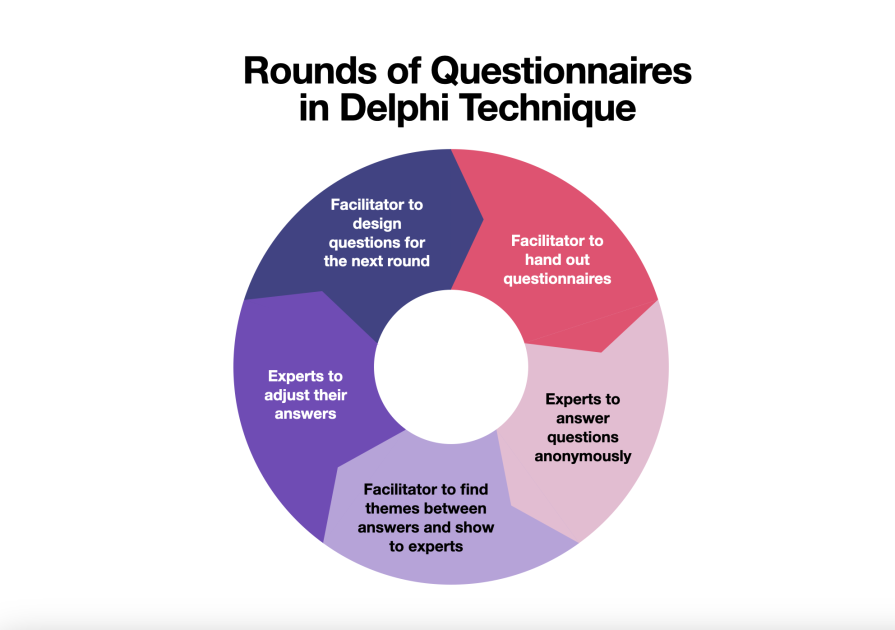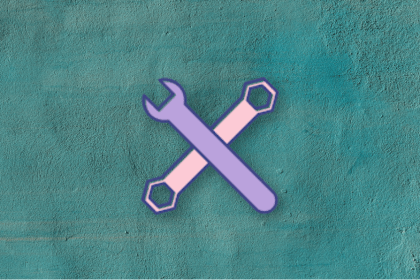Product managers have to wear multiple hats at work. One of these hats requires you to facilitate meetings. Everyone appreciates an effective, efficient meeting, and the Delphi technique can help you do this.

Besides facilitation, the Delphi technique is a great tool for decision-making. It’s commonly used in various fields, including business, healthcare, technology, and public policy.
In this article, you’ll learn more about the Delphi technique including its five steps, benefits, and use.
The Delphi technique is a systematic method for group decision-making. It’s used to gather opinions from a group of knowledgeable members to reach a group consensus. The process typically involves several rounds of questionnaires where the responses remain anonymous.
You can incorporate the Delphi technique into your product team by following five easy steps.
In product management, people tend to emphasize the “problem space” or the “problem statement.” You first have to understand the problem to solve, the purpose of the study, and the goal you want to achieve before conducting research.
In this step, the problem statement needs to be clear and specific. It outlines the gap between the current state and the desired state, providing a foundation for further investigation and problem-solving. With a clear problem statement, you can smooth out the process in later steps.
The central tenet of the Delphi technique involves consulting with relevant stakeholders or individuals with expertise. Different perspectives can provide valuable insights and help the panel consider aspects that might have been overlooked.
In the previous step, you identified the problems to solve. Now you need to determine which “subject matter experts” to include, depending on the complexity of the problem.
The facilitator of the Delphi process is usually, but not limited to, a product manager, project manager, or program manager. The facilitator should be neutral and have enough domain knowledge to understand the conversations.
To complete the Delphi process, you need to run multiple rounds of questionnaires or surveys. In each round, you’ll ask the panel of experts to provide their opinions, predictions, or judgments on a list of questions for the problem determined in the first step:

The above illustration shows how the rounds of questionnaires are iteratively designed and answered:
You can distribute your questionnaires before each round. Generally, there should be at least two rounds of questionnaires. The first round is usually for asking high-level questions to kickstart the whole process. The rest of the rounds are for follow-up questions and for experts to adjust their answers until a general group consensus is reached.
Once the panel of experts reaches a consensus, we can analyze the results and evaluate risks. The team can create plans and action items.
The Delphi technique provides three key benefits for you as a product manager.
The responses of each expert are kept anonymous. This helps to avoid the influence of dominant personalities or opinions within the group. This setup also encourages open and honest sharing of opinions.
The Delphi technique is a structured and systematic process involving multiple rounds of feedback and iteration. The opinions of the subject matter experts can be refined over time, leading to a more reliable outcome.
Groupthink is a psychological phenomenon where group members tend to conform to a dominant viewpoint without critical evaluation to avoid conflicts. In the Delphi process, by collecting individual opinions independently and collating them without direct interaction among participants, the risk of groupthink is minimized.
Although there are benefits to the Delphi technique, you should be aware of the disadvantages that come along with them to prevent affecting your process.
Multiple rounds of feedback and iteration take a lot of time. While choosing a decision-making process, you need to consider the time constraints. The Delphi technique may not be the best option if your organization needs to reach a quick decision in a short timeframe.
The success of the Delphi technique heavily depends on the expertise and knowledge of the participants. If the experts have biases or limited perspectives, it can impact the quality of the final outcome.
The Delphi technique may be less effective in dealing with highly complex or technical issues where consensus is hard to achieve, or where there is a lack of relevant expertise among the participants.
Product managers can leverage the Delphi technique to gather insights, make informed decisions, and forecast outcomes. Here are some areas PMs can try.
In the early stage of product development, you have to conduct research to find product-market fit. While conducting market validation for your product, it’s crucial to gather expert opinions on market trends, demand for specific features, or predictions for future market conditions.
By using the Delphi technique, you can obtain insights into potential shifts in customer preferences and emerging market opportunities. On the other hand, PMs can explore potential opportunities and threats in the market with the Delphi technique as well.
While conducting competitor analysis, insights from subject matter experts make the analysis more complete regarding competitor strategies, strengths, and weaknesses. The Delphi technique can help product managers forecast potential competitive moves and assess the impact on their long-term product strategy.
The Delphi technique is a valuable tool for product managers. The five-step method ensures a systematic approach to group decision-making by leveraging the expertise of subject matter experts while maintaining anonymity throughout the process.
The goal of the Delphi technique is to achieve a consensus or convergence of opinions among the experts. The final results are based on the collective judgment of the group. It helps to mitigate the impact of groupthink and interpersonal dynamics that can affect traditional group decision-making processes.
Featured image source: IconScout

LogRocket identifies friction points in the user experience so you can make informed decisions about product and design changes that must happen to hit your goals.
With LogRocket, you can understand the scope of the issues affecting your product and prioritize the changes that need to be made. LogRocket simplifies workflows by allowing Engineering, Product, UX, and Design teams to work from the same data as you, eliminating any confusion about what needs to be done.
Get your teams on the same page — try LogRocket today.

Stop letting unreliable data block features. Treat data as inventory to track quality, ownership, and ship with confidence.

Learn why slide decks slow teams down and explore better tools like whiteboards, PRDs, and prototypes to improve collaboration and alignment.

AI PM roles are evolving fast. Learn the five types of AI PMs, the skills they need, and how they shape AI products across industries.

Learn how you can use AI agents to automate workflows, boost productivity, and choose the right tools while avoiding common pitfalls.